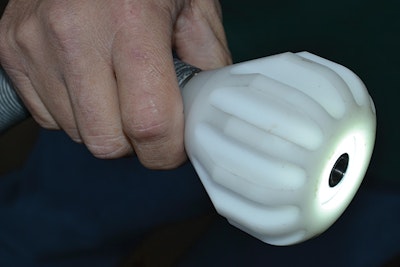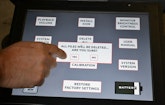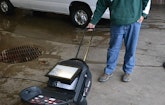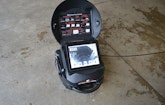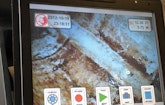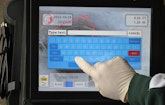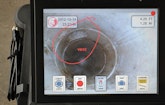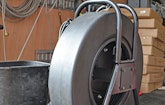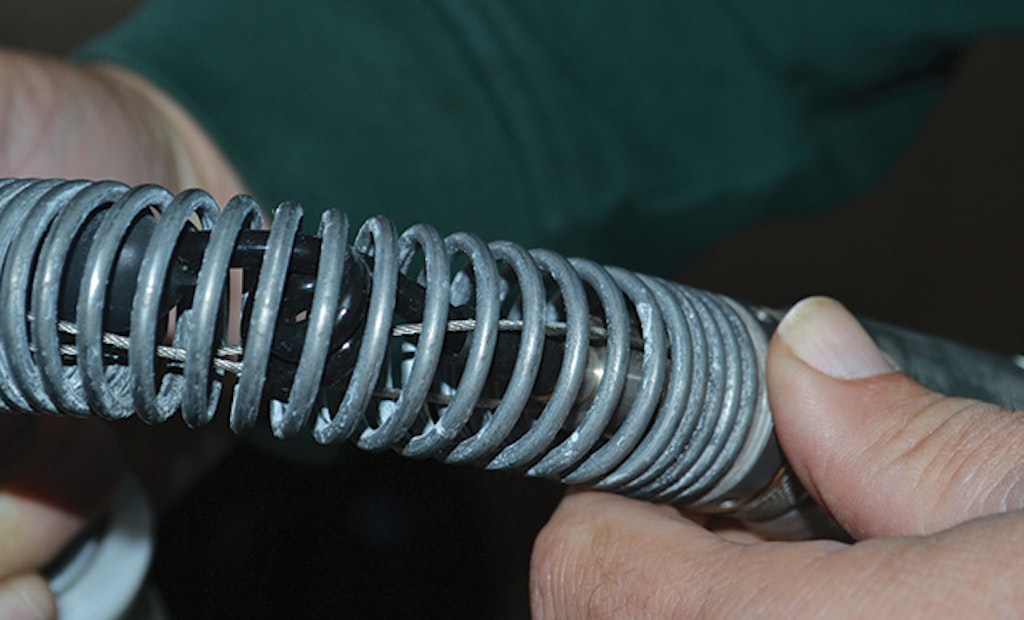
Interested in Inspection?
Get Inspection articles, news and videos right in your inbox! Sign up now.
Inspection + Get AlertsSewer cameras are continually updated with new features and capabilities. Among the newer product lines now on the market is the PROvision Touch Camera System from Spartan Tool, LLC.
The PROvision Touch is a push camera equipped with powerful LED lighting and various sizes of hard plastic centering rings to accommodate various sizes of small pipe, including 2-, 3- and 6-inch options. But the more intriguing element of the system is its small footprint and the use of its video screen as a touch-screen-based control system.
Brian Willis, territory sales manager for Spartan Tool, conducted a demonstration of the PROvision Touch system on Friday, Oct. 19, 2012, at the vehicle garage of Mark's Reddi Rooter service in Madison, Wis.
Walk-around
The PROvision Touch system utilizes a cable-mounted push camera 1.375 inches in diameter. The stainless steel, self-leveling, color camera has a scratch-resistant sapphire glass lens surrounded by a ring of LED lights for illumination. The camera is attached to a 100-foot line; a 200-foot secondary line is also available. Immediately behind the camera, the cable is shielded with a coil-spring-like flex link, which Willis said is somewhat bigger than what is typically used and provides better protection for the cable when navigating tight turns.
The camera system's primary cable reel is mounted inside a 21-inch by 21-inch by 11-inch molded case that also contains the system controls, viewing screen and recording technology. When packed, the case and its contents weigh 54 pounds.
The 15-inch LCD viewing monitor is bright enough to be easily visible in daylight as it displays images from the camera. The screen is hinged to allow the user to set an optimum viewing angle for a particular location and position.
The monitor also functions as the system control panel, using touch-screen technology and on-screen control button icons.
In normal usage, the bottom of the screen displays five touch-screen icons for controlling the camera, recording video, playing video, taking a still "snapshot" during an inspection, and opening other control menus.
Other specific function button icons are displayed depending on the exact process under way. For example, if the system is making a recording, a button becomes available to stop the recording.
The system's distance counter display, which can be reset by touching the counter display, is positioned at the top right of the screen. A date-and-time display is at the top left.
The touch-screen system controls the camera and the recording, and is also used to access the files made during the inspection along with electronic files containing the system's user manual. "You can scroll through the pages of the manual," Willis said.
Other controls allow the user to set the playback volume and other specifications, and an on-screen icon that resets the system to factory defaults is also provided.
An on-screen virtual QWERTY keyboard allows the operator to record information during an inspection. The touch screen also provides the ability to mark areas along a pipe while conducting inspections, simply by outlining the image with a finger on the screen.
The screen controls can also be hidden with the touch of a finger to allow for full-screen viewing, then can be restored as needed to control the system simply by touching the area of the screen where the control icons are normally located.
Data is recorded directly to a flash drive that can be easily removed for transfer to a PC or computer network for analysis and archiving.
"If we ever have an issue where we have to do an update for the system software, all we have to do is put in a thumb drive ... with the update," Willis said.
The system runs off either 110-volt conventional AC current or a 12-volt, lithium polymer rechargeable battery pack.
When the system's secondary 200-foot cable is employed, it is plugged into a dedicated port on the system case unit. When that happens, the system automatically switches transmission to that port, just as an audio device will automatically turn off its speakers when a user plugs in a headphone set.
Spartan's smaller, black-and-white Trap Eze camera, used for much smaller drains such as sinks or toilets, can also be used with the PROvision Touch control system.
Operation
Willis began by fastening the 2-inch centering collar in place on the outside of the camera, then lowering it into the 2-inch drain line selected for the inspection. The line led to a catch basin, then to a pipe that connected with the sanitary sewer system.
Touching the upper right distance counter display opened a small menu that allowed him to reset the counter to zero. After zeroing the line counter, he touched the red-dot "record movie" icon at the lower left of the screen, which began recording the inspection. A red dot in the corner of the screen indicated that recording was under way.
The drain had recently been cleaned, so as Willis pushed the camera in, the images it returned to the screen showed little in the way of obstruction or defects. The images on the screen were bright, sharp and well lit. The screen was clear and easily viewed.
Willis continued pushing the camera into the line. As he did so, he pointed out that because of the camera's self-leveling capability, the picture was always oriented properly so that up was up on the screen and down was down.
Several feet in, Willis observed on the screen a vent in the line leading off to the upper left. With his finger, he drew a circle around the vent on the screen. The action left a visible, black electronic circle on the image — reminiscent of the lines that football sportscasters make on the television screen to diagram plays for viewers. Willis touched the screen icon that controlled the keyboard and drawing functions, and brought up a menu to change the color of the hand-drawn circle from black to red to enhance its visibility.
Willis used the same touch-screen icon to call up the touch-screen keyboard, then labeled the site "vent."
At 7.2 feet, Willis encountered an elbow in the sewer line. He touched the snapshot icon to get a still picture, and used the touch-screen keyboard to label it "elbow." Taking the snapshot did not interrupt the video recording, Willis noted.
Willis continued to extend the camera into the line, reaching a distance of more than 40 feet. The images showed a clean line and then showed soap bubbles, believed to have been sent into the drain earlier when the crew from Mark's Reddi Rooter had washed some equipment.
Nearing the end of the line where it connected with the larger sanitary sewer line, Willis touched an on-screen button icon labeled "end movie" to stop the video recording. He then began drawing back the camera, cleaning off the push rod before winding it back onto the reel.
After withdrawing the camera, Willis demonstrated the playback features. He used the touch screen to bring up a list of recorded files: an AVI file for the video and a PNG file for the still picture.
"If we want to do a copy of the video, all we have to do is put another flash drive in, hit copy, and it will copy to the flash drive. Then we can give the flash drive right to the customer," Willis said.
During playback, a series of touch-screen buttons for controlling the playback appeared, with options to play, stop, pause, fast forward, fast reverse, skip back and "slide" ahead in the video, using the operator's finger. Willis also was able to display the snapshot taken during the inspection.
Observer's suggestions
The images on the touch-screen monitor were sharp, very clear and very easy to see in a variety of light conditions.
At times, viewing the counter on the screen became confusing. Willis explained that the counter takes its information from the reel as it turns to feed out the push rod. Thus, if there's slack in the push rod and the reel doesn't actually turn for a time while the camera is pushed out, the moment-to-moment distance reading may not always correspond to the exact location of the camera.
Users will want to keep slack to a minimum while pushing the camera into the line being inspected.
Manufacturer's comments
Willis noted that users may wish to focus more on the images they receive when bringing the camera back from the far end of the line it is viewing. "When you're bringing the thing back you can get a better picture than when you're going forward because you don't have something obstructing the camera head," he explained.
A sonde-type beacon in the camera head that emits a 512 MHz signal makes it relatively easy to locate the underground camera by an operator working at street level with a locator set to the appropriate frequency, Willis said.
Willis noted that a business or other organization purchasing the unit can have its own logo incorporated into the opening splash screen visible on the unit.
The monitor uses a sapphire glass-covered screen, which Willis noted can be cleaned with conventional glass cleaners, such as Windex or similar products. "People do not have to worry about it if they've got dirty hands," he said.
The centering guides will fit in conventional PVC-based pipe. When using the camera in other pipe materials, such as cast iron, which may accumulate buildup, the user may wish to use a smaller centering guide than normal, Willis said. For instance, a 6-inch guide might be appropriate for an older, 8-inch cast iron pipe with significant buildup inside it.
